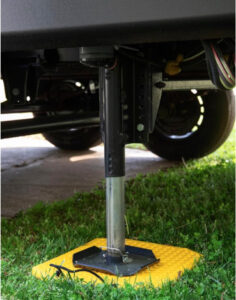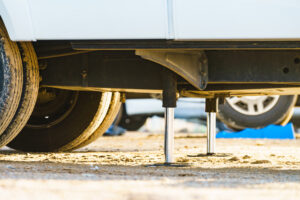Level Ground: What Dealers & Technicians Need To Know About RV Jacks & Levelers
Proper stabilization and leveling keeps your customer’s RV safer, more comfortable and less prone to damage.

For most RVers, the journey doesn’t truly begin until they’re settled into their campsite. Yet the first task upon arrival — getting the rig level and stable — can set the tone for the entire trip. When jacks or levelers aren’t used properly, even a beautiful destination can become a frustrating experience. Dealers and technicians play a crucial role in guiding customers through this often-overlooked aspect of RV ownership. Understanding the various systems, their maintenance needs and the safety concerns involved can make all the difference in how a customer enjoys their RV.
A Foundation of Stability
Not all RVs are equipped with the same type of leveling or stabilizing equipment. Smaller towables might come with simple scissor jacks, operated by hand crank or cordless drill. These are affordable and reliable, but they are designed to stabilize the unit, not to truly level it. Larger travel trailers will often add an electric tongue jack to make hitching and front-to-back leveling easier, while many owners supplement with wheel chocks and blocks for side-to-side adjustments.
Move up to a fifth wheel or motorhome, and the systems become more sophisticated. Automatic hydraulic jacks, controlled by the push of a button, are now common on Class A and Class C motorhomes as well as higher-end towables. Some manufacturers are blending electric and hydraulic systems to offer more efficient, user-friendly options at mid-range price points. For the customer, the convenience of arriving, pressing a button and watching the coach stabilize itself is hard to beat.
For the dealer or technician, the key is to help customers understand that different systems serve different purposes. Stabilization and leveling are not interchangeable, and confusing the two can lead to costly damage.
Why Leveling Matters
 A level RV is more than just a comfort feature. When a coach is out of balance, the stress ripples across the entire unit. Doors may swing open unexpectedly. Slides can’t operate under uneven strain. Refrigerators that rely on absorption technology may fail prematurely. Even chassis components can suffer when stabilizers are misused as levelers, leading to bent frames or weld fatigue.
A level RV is more than just a comfort feature. When a coach is out of balance, the stress ripples across the entire unit. Doors may swing open unexpectedly. Slides can’t operate under uneven strain. Refrigerators that rely on absorption technology may fail prematurely. Even chassis components can suffer when stabilizers are misused as levelers, leading to bent frames or weld fatigue.
Dealers should emphasize these points during delivery walk-throughs. Customers need to understand that leveling their RV isn’t simply about preventing their morning coffee from sliding off the table — it’s about protecting their investment and ensuring safety.
Safety Concerns on the Road & in the Shop
Improper use of jacks and levelers is one of the most common mistakes RV owners make. A frequent error is attempting to raise and level the RV using stabilizer jacks, which were never engineered for that purpose. This can result in bent arms, damaged mounting points and a compromised frame.
Another hazard arises when owners deploy hydraulic jacks or electric stabilizers on soft surfaces like asphalt or damp soil. Without jack pads or blocks to spread out the weight, jacks can sink into the ground, leaving the RV unsteady. And while electric and hydraulic systems add convenience, they also add dependence on a healthy 12-volt battery system. A dead battery can leave an owner unable to hitch, unhitch or level their coach.
It’s also important to stress that no jack system — manual or automatic — should ever be used in place of proper supports when working under the RV. For technicians, reinforcing this safety message helps prevent accidents and liability.
Maintenance Matters
 Like every other system on an RV, jacks and levelers require routine attention. Hydraulic systems should be cycled monthly to keep seals lubricated and to prevent fluid from pooling. Checking fluid levels, inspecting for leaks and keeping an eye out for worn hoses are essential service steps.
Like every other system on an RV, jacks and levelers require routine attention. Hydraulic systems should be cycled monthly to keep seals lubricated and to prevent fluid from pooling. Checking fluid levels, inspecting for leaks and keeping an eye out for worn hoses are essential service steps.
Electric jacks require technicians to inspect wiring, motors and connections for corrosion, especially on rigs that have seen a lot of weather. Manual scissor jacks, though simple, benefit from periodic lubrication of the screw threads to prevent binding and rust. Across all systems, bolts, welds and mounting brackets should be inspected for fatigue — especially after long journeys on rough roads.
By educating customers on these points, technicians not only prevent unnecessary breakdowns but also build trust. Customers who feel their dealer or service provider is invested in their long-term safety are more likely to return for future work.
Helping Customers Choose Wisely
When assisting buyers, the question isn’t just “what does this RV come with?” but “what does this customer truly need?” Weekend campers who only set up a few times a year may find manual systems perfectly adequate, while full-timers or older customers with mobility issues will likely appreciate the ease of push-button leveling. Larger, heavier rigs almost always benefit from hydraulic support, and for those customers, the convenience should be positioned as an investment in both time and safety.
Budget naturally plays a role, but so should long-term thinking. A customer who tries to save a few hundred dollars up front may spend much more later repairing damage caused by improper leveling. Dealers and technicians who explain this trade-off clearly often find that customers are willing to choose quality once they understand the stakes.
What’s New in the Market

The aftermarket for jacks and levelers has grown rapidly in recent years, with innovations designed to make the process easier and safer. Many systems now offer Bluetooth connectivity, allowing users to monitor and control leveling from their smartphones. Lightweight materials, such as aluminum, are reducing the overall weight of systems without compromising strength. Wider footpads are being introduced to combat the problem of jacks sinking into soft ground, and retrofit kits allow owners of older RVs to add electric stabilizers or wireless controls to their rigs.
For dealers, staying informed about these advancements provides an opportunity to upsell while genuinely improving the customer’s experience. Highlighting a product’s time-saving or safety-enhancing features can turn what might feel like an optional upgrade into an essential purchase.
Education as a Value-Add
Ultimately, what customers need most is education. Demonstrating the difference between stabilization and leveling, showing them how to properly deploy their system and providing tips for routine care can transform frustration into confidence. A short demo during the delivery process — complete with reminders about pads, lubrication and system limitations — goes a long way.
For service departments, creating a standard checklist for jack and leveler inspection not only improves customer safety but also positions the dealership as a trusted resource. By treating jacks and levelers as more than just mechanical add-ons, dealers and technicians help ensure that customers enjoy safe, comfortable and trouble-free adventures.
Final Word
Jacks and leveling systems may never be the flashiest feature of an RV, but they are among the most critical. A coach that is stable and level is safer, more comfortable and less prone to damage. Dealers and technicians who understand the nuances of these systems — and who take the time to share that knowledge with their customers — help create a stronger, more professional industry. And for RVers, that means more time enjoying the view and less time worrying about what’s happening under their rig.


